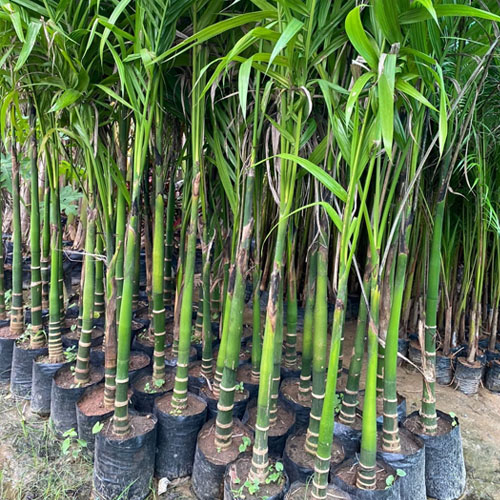Supari Plants
Supari refers to the betel nut or areca nut (Areca catechu), which is the seed of the betel palm. It is commonly used in various cultural practices and as a chewable stimulant in many parts of Asia. The plant is also known for its ornamental value and as a source of income in many tropical regions.
Characteristics of Supari Plants
-
Size and Growth Habit: The betel palm is a tall, slender, and erect palm that can grow up to 66 feet (20 meters) tall. It has a smooth trunk and a crown of feathery, pinnate leaves at the top.
-
Leaves: The leaves are large, pinnate (feather-like) and can grow up to 6-8 feet (1.8-2.4 meters) long. They are bright green and provide a tropical aesthetic.
-
Flowers: The betel palm produces small, inconspicuous flowers that are grouped in dense clusters. The flowers are not particularly showy but are crucial for fruit production.
-
Fruit: The fruit of the betel palm is a round to oval nut, which is green when immature and turns brownish when mature. Each fruit contains a single seed, which is the actual betel nut. The mature nuts are harvested and dried for use.
-
Lifespan: Betel palms can live and produce fruit for several decades under favorable conditions.
Growing Conditions
-
Climate: Betel palms thrive in tropical climates with warm temperatures year-round. They prefer high humidity and can tolerate a range of temperatures but are sensitive to frost and cold.
-
Soil: These palms grow best in well-draining, sandy loam soils. They can adapt to various soil types but prefer slightly acidic to neutral soil (pH 6.0-7.0). Good drainage is essential to prevent root rot.
-
Sunlight: Full sun to partial shade is ideal for betel palms. They require bright light for healthy growth but can tolerate some shade.
-
Watering: Regular watering is important, especially during dry periods. The soil should remain consistently moist but not waterlogged. Avoid overwatering, which can lead to root rot.
Care Requirements
-
Pruning: Prune the lower, dead fronds as needed to maintain a tidy appearance and to promote airflow. Avoid heavy pruning, as the palm relies on its fronds for nutrient production.
-
Fertilization: Apply a balanced fertilizer or palm-specific fertilizer periodically to support healthy growth and fruit production. Fertilize in early spring and during the growing season.


